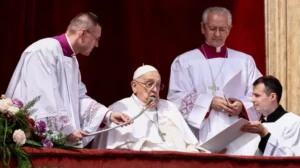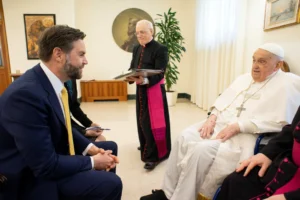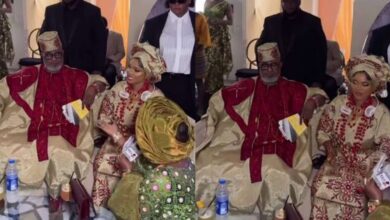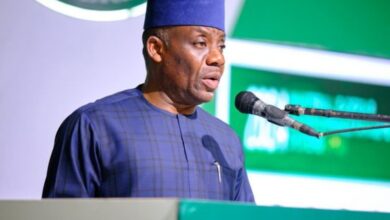Pope Francis’ Celebrates Easter Against All Odds

Pope Francis’ Celebrates Easter Against All Odd-Dawn broke over Rome with an almost celestial glow on Easter morning, casting long shadows across the cobblestones of St. Peter’s Square. The air hummed with anticipation as 60,000 faithful pilgrims craned their necks toward the central balcony of the basilica. Then, at precisely noon, the moment arrived:
A wheelchair rolled forward.
The crowd’s collective gasp was audible as 88-year-old Pope Francis, looking noticeably thinner but radiating quiet determination, raised a trembling hand in greeting. His voice, though weakened by illness, carried across the silent square with startling clarity:
“Cari fratelli e sorelle, buona Pasqua.”
This simple Easter greeting marked far more than a seasonal blessing—it represented the culmination of a medical ordeal that had brought the pontiff to death’s door just weeks earlier. The frail man in white vestments now addressing the world had spent 38 harrowing days hospitalized with double pneumonia, suffering what his doctors later described as “two distinct life-threatening episodes.”

A Medical Miracle in Real Time
The backstory of Francis’ hospitalization reads like a medical thriller. Admitted in mid-February with what was initially described as a “respiratory infection,” the pontiff’s condition rapidly deteriorated into severe pneumonia affecting both lungs—a particularly dangerous development for a man who lost part of his right lung to infection at age 21.
Vatican sources reveal chilling details:
- Oxygen saturation levels dropping below 90% at the crisis point
- Around-the-clock monitoring by a team of six specialists
- Emergency consultations with pulmonary experts from Rome’s Gemelli Hospital
“His life was absolutely in danger—twice,” confessed Dr. Sergio Alfieri, the lead surgeon who oversaw Francis’ care. “The combination of his age, compromised lung capacity, and the virulence of the infection created a perfect storm.”
Yet against all odds—and medical predictions—the Pope staged a recovery remarkable enough that by Easter Sunday, he had graduated from hospital bed to basilica balcony without the nasal cannula oxygen tubes he’d been using just days earlier.
The Hidden Cost of Leadership
Those expecting a fully recovered pontiff, however, received sobering reminders of his continued frailty:
Physical Limitations
- The traditional two-hour Easter Mass was abbreviated to 90 minutes
- Francis remained seated throughout the ceremony
- His once-firm voice now carries a noticeable breathlessness
Delegated Duties
For the first time in his 12-year papacy:
- The Holy Thursday foot-washing ritual was performed by a cardinal
- Good Friday’s Via Crucis at the Colosseum was led by another prelate
- The Easter Vigil’s lengthy scripture readings were shared among clergy
“This isn’t the Pope we knew in 2013,” noted veteran Vatican correspondent Gerard O’Connell. “But what he’s lost in physical stamina, he’s gained in moral authority. There’s something profoundly moving about a leader who pushes through such obvious discomfort to fulfill his spiritual duties.”
Urbi et Orbi: A Message for Our Fractured Age
When the moment came for the traditional “Urbi et Orbi” (To the City and the World) blessing—the only part of the liturgy that canonically requires the Pope’s personal participation—Francis surprised observers by delivering the opening lines himself before yielding to an aide.
His message blended spiritual reflection with razor-sharp political commentary:

On Gaza’s Unfolding Catastrophe
“The once-vibrant Christian community of Gaza now clings to survival amid indiscriminate destruction,” he declared, his voice gaining strength as he described visiting Gaza’s sole Catholic church in 2021. “I plead with the warring parties: Stop this slaughter of innocents! Release the hostages! Let bread reach the starving!”
The Shadows of Antisemitism
In a passage that drew particular attention given recent campus protests across Europe and America:
“The ancient specter of Jew-hatred walks among us once more—in university halls, on city streets, across social media. This poison must be named and condemned by all people of conscience.”
Ukraine’s Forgotten War
While avoiding direct criticism of either side, Francis made his position clear:
“There are no victorious wars, only vanquished humanity. Every day this conflict continues represents another failure of our collective moral imagination.”
The Vance Encounter: Theology Meets Realpolitik
The most politically charged moment of the day occurred not in the square but behind Vatican walls, where U.S. Vice President JD Vance—a recent convert to Catholicism—held a 25-minute private audience with the pontiff.
Sources describe an encounter rich with unspoken tension:
- Vance presented the Pope with a first-edition copy of Fulton Sheen’s Life of Christ
- Francis gifted the VP a medallion of Saint Martin de Porres, patron of racial harmony
- Their discussion reportedly touched on migration—a flashpoint issue given Francis’ past criticism of Trump-era border policies
Vatican spokesman Matteo Bruni later characterized the meeting as “cordial,” though observers noted the carefully worded statement omitted any mention of the immigration discussions that dominated their last encounter.

The Jubilee Year Dilemma
Complicating the Pope’s recovery timeline is the ongoing Holy Year—a special Jubilee that occurs only once every quarter-century. Normally a time of increased papal activity, the event now poses serious challenges:
Scheduled Demands
- Weekly general audiences through December
- Six canonization ceremonies
- Multiple basilica visits requiring lengthy processions
Physical Realities
- Doctors recommend avoiding large crowds until June
- Speech therapy continues for lung recovery
- Limited stamina for prolonged standing
“The Jubilee can’t be postponed, but neither can the Pope’s health,” notes church historian Massimo Faggioli. “We’re likely to see unprecedented delegation of duties to the College of Cardinals.”
The Succession Question
Though Francis has repeatedly dismissed retirement rumors, his hospitalization has reignited discussions about papal succession. Key considerations:
Precedent
- Benedict XVI’s 2013 resignation broke a 600-year tradition
- Francis has called Benedict’s decision “courageous” but hasn’t endorsed it as a model
Practicalities
- The Vatican has quietly updated its conclave procedures
- Several key curial appointments appear aimed at shaping future leadership
The Francis Factor
Those closest to the Pope insist resignation isn’t under consideration. “He sees his physical limitations as part of his spiritual witness,” explains one aide. “The image of a suffering servant has deep roots in Christian tradition.”
The Ripple Effects
Beyond Vatican walls, Francis’ health struggles are reshaping Catholic dynamics worldwide:
Progressive Hopes
Reformists worry unfinished business—from female deacons to married priests—may stall without Francis’ direct leadership.
Conservative Calculations
Traditionalist factions see an opportunity to roll back changes, particularly on Latin Mass restrictions.
Global South’s Rising Voice
African and Asian bishops increasingly assert their priorities, knowing this may be Francis’ final year to advance their agenda.
A Living Testament
As dusk fell on Easter Sunday, the Pope made one final lap through St. Peter’s Square in his open-top jeep. Pilgrims wept as he slowly blessed babies handed to him by Swiss Guards. In that moment, the paradox of this papacy became vividly clear:
Here was a man physically diminished yet spiritually magnified—a walking testament to the Christian ideal that strength is perfected in weakness.
Whether this marks Francis’ last Easter or the start of an improbable new chapter remains unknown. What’s certain is that in an age of soundbite leadership and disposable celebrities, the world is witnessing something rare:




